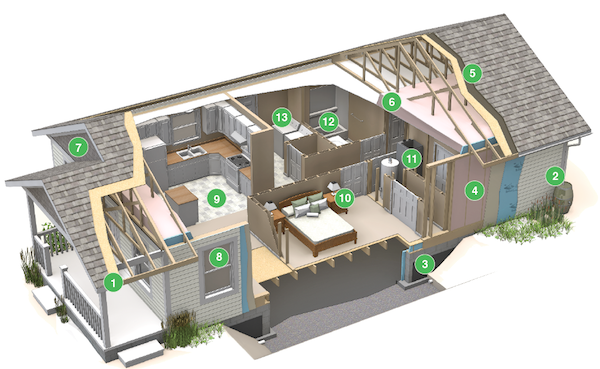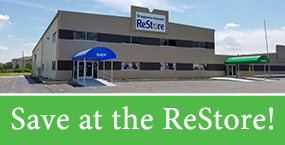Green Building
In 2011, Greater Muncie Habitat for Humanity partnered with ENERGY STAR and began building 100% of our new houses to meet ENERGY STAR requirements. Currently, we are the only builder in Muncie to make this commitment. ENERGY STAR qualified homes are at least 15 percent more energy efficient than homes built to the 2004 international residential code (IHC). These energy-saving features typically make them 20–30% more efficient than standard homes.
What qualifies as an ENERGY STAR home?
ENERGY STAR homes can include a variety of energy-efficient features as detailed by the diagram below.

-
1. Passive Solar Design
- Free energy of the sun is collected in simple and cost-effective ways to reduce energy consumption in the home.
- Windows are placed on the south side of the home to encourage heat gain during the winter months. During summer months, a two foot roof overhang protects against over-heating.
- More windows are intentionally placed on the south side of the home while windows on the east, west, and north sides are protected and minimized. This helps us control how much solar heat is collected.
-
2. Rain Barrels & Landscape
- The home is equipped with a rain barrel to collect storm water and make it available for watering plants and vegetables.
- Rain barrels play an important role in the creation of passive storm water systems by slowly releasing water into the ground and reducing the load on city sewers.
-
3. Foundation & Crawlspace
- The crawlspace is tightly sealed, ventilated, insulated, and becomes a natural part of the building’s thermal envelope.
- A tightly sealed crawlspace prevents unnecessary energy losses and improves overall comfort.
-
4. Wall Construction
- Advanced framing methods prevent waste in the construction process and provide additional opportunities for thermal protection.
- 2×4” exterior walls placed 16” on-center use less lumber and allow R-13 batt insulation to fill the cavity. The frame is wrapped with 3/4” plywood and a layer of R-5 rigid insulation. A total R-value of 24 creates an energy efficient wall system.
- When available, we use dimensional lumber certified by the Forrest Stewardship Council (FSC). The FSC ensures that certified lumber is sustainably harvested to protect our forests.
-
5. Roof Construction
- A raised-heeled truss creates more room for insulation than traditional methods and helps to ensure a continuous thermal envelope around the home.
- Roofs are clad with a 30-year dimensional shingle that will provide low maintenance and should outlast the mortgage of a new home.
-
6. Thermal Envelope & Air Sealing
- An ENERGY STAR certified home ensures that unwanted outside air is prevented from coming inside. Adhesives and sealants contain low or no Volatile Organic Compounds (VOCs).
- A thermal barrier of rigid and batt insulation begins in the crawlspace and wraps the entire house to protect against energy loss.
-
7. Siding & Trim
- Siding: Vinyl siding is used because it is affordable for homeowners and offers durability with low-maintenance.
- Trim: LP Smartside is an engineered wood product that complies with both NAHB and LEED home rating systems as a renewable resource.
-
8. Windows
- Windows play a vital role in protecting the energy efficiency of the home.
- Habitat homes use ENERGY STAR, double hung windows with Low-E/argon glass.
-
9. Interior Finishes
- Vinyl flooring covers the kitchen, utility room, laundry room, and bathroom. Vinyl flooring is used because it is affordable for homeowners and offers durability with low-maintenance.
- Shaw Green Edge carpets are made of 100% BCF Nylon and can be recycled at the end of its lifespan. The carpet pad is made of 100% recycled content and carries the Green Label certification from the Carpet and Rug Institute.
-
10. Lighting
- ENERGY STAR qualified light fixtures are used throughout the home. Compact florescent light bulbs (CFLs) are used with each fixture.
- Occupancy sensors and motion sensors save energy by turning off lights when people are not in the room.
-
11. Heating, Cooling, & Utilities
- ENERGY STAR air conditioning and high efficiency 95+ gas heat is used in all new Habitat homes.
- Tank water heaters are typically selected for affordability and efficiency. In some situations gas tankless water heaters (more expensive upfront but have substantial energy savings over time) will be installed.
-
12. Plumbing Fixtures
- ENERGY STAR water fixtures are used throughout the home.
- A WaterSense certified low-flow showerhead in the bathroom prevents excess use of water.
- A WaterSense high performance toilet uses only 1.28 gallons of water per flush.
-
13. Appliances
- Habitat homes use ENERGY STAR Whirlpool brand appliances.
- ENERGY STAR refrigerator and clothes washer provide hundreds of dollars in energy savings over traditional models.
- Using an Energy Star washer reduces energy consumption by one third and water bills by more than half.




